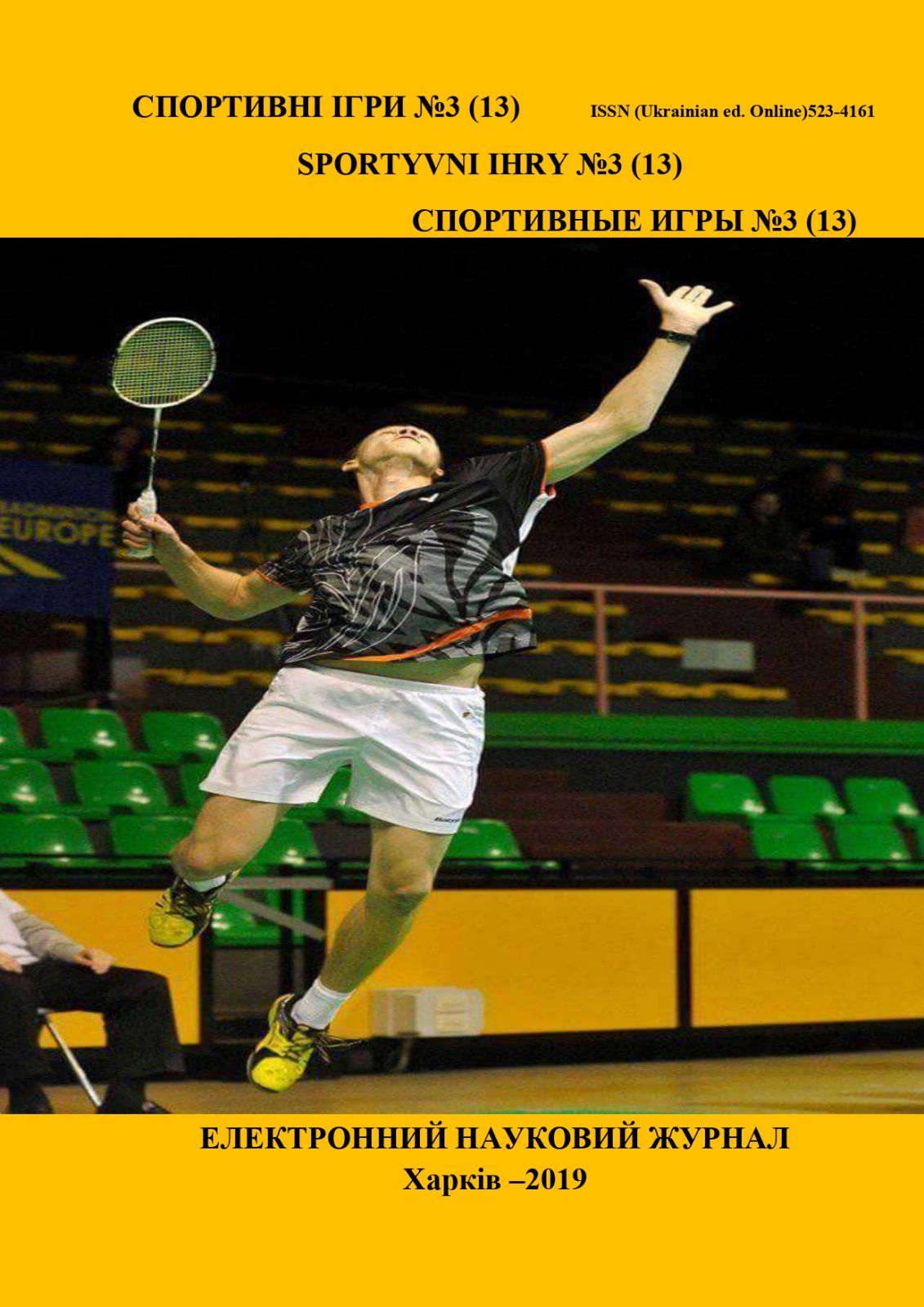Формування рухових якостей дітей старшого дошкільного віку під впливом занять міні-тенісом
DOI:
https://doi.org/10.15391/si.2019-3.02Ключові слова:
міні-теніс, фізичні якості, старший дошкільний вік, методикаАнотація
Актуальність статті обумовлена сучасними тенденціями розвитку міні-тенісу в Україні та недостатньою науково-методичною базою з організації та проведення навчально-тренувальних занять з дітьми старшого дошкільного віку. Вітчизняними
дослідниками приділяється увага підготовці кваліфікованих тенісистів, існують роботи з
оптимізації навчально-тренувального процесу, проте питання присвячені методиці
побудови занять для дітей з міні-тенісу на етапі початкової підготовки залишаються не
достатньо висвітлені. Мета дослідження: перевірка впливу та ефективності методику
розвитку фізичних якостей дітей старшого дошкільного віку у процесі занять міні-тенісом.
Матеріал і методи дослідження: під час організації дослідження проводився аналіз та
узагальнення науково-методичної літератури; анкетування, педагогічне спостереження,
тестування фізичних якостей, використовувалися методи математичної статистики.
Дослідження проводилось протягом 2017-2019 рр., яке передбачало ряд послідовних етапів.
У досліджені брали участь 16 дітей старшого дошкільного віку, які займались тенісом у
групі початкової підготовки першого року навчання на базі тенісного клубу «Унікорт» м.
Харкова три рази на тиждень по 60 хвилин. Результати дослідження: для визначення
ефективності запропонованої методики нами було визначено рівень фізичної
підготовленості та технічного засвоєння рухів «школи м’яча», підбір тестів здійснювався з
урахування специфіки виду спорту. Отриманні результати свідчать про позитивний вплив
занять тенісом на розвиток фізичних якостей, а особливо швидкісних, координаційних та
швидкісно-силових якостей дітей старшого дошкільного віку. Результати свідчать про
однаковий рівень фізичної підготовленості дітей старшого дошкільного віку на початку
занять тенісом і достовірні відмінності між контрольною та експериментальної групою
відсутні. Необхідно зазначити відсутність однорідності результатів, оскільки коефіцієнт
варіації складає від 26,4% до 35,2%, за винятком експериментальної групи у тесті – «біг на
5 м з високого старту» (V =12,2%). Аналіз отриманих результатів свідчить про
підвищення рівня фізичної підготовленості як у контрольній так і в експериментальній
групах наприкінці першого року тренування. Відповідно до коефіцієнта варіації можна
говорити про те, що результати у внутрішньо груповій вибірці стали більш однорідними і
вказують на більш однаковий рівень підготовленості дітей порівняно з результатами до
початку занять тенісом. Висновки. Аналіз зарубіжної наукової, навчальної і методичної
літератури свідчить, про те, що міні-теніс в системі організації та проведення навчально-тренувального процесу є ефективним засобом в формуванні інтересу до занять та позитивно впливає на розвиток фізичних якостей у дітей віком до 8 років. Ефективність
розробленої методики підтверджується достовірними приростом показників рівня
розвитку фізичних якостей дітей відповідного віку у тестах – біг на 5 м з високого старту,
стрибок в довжину з місця, кидок м’яча на дальність, човниковий біг «віяло», хват падаючої
палки, метання м’ячів у квадрати та десять вісімок при р<0,01–0,01.
Посилання
Аль Халик, Махмуд (1997). Направленность и содержание физической подготовки теннисистов в группах начального обучения ДЮСШ: (Doctoral dissertation). Киев, Украина.
Боллетьери, Н. (2003). Теннисная академия : пер. с англ. Москва : Эксмо.
Бондаревский, Е. Я. (1983). Информативность тестов, используемых для характеристики физической подготовленности человека. Теория и практика физ. культуры. 1, 23-25.
Вильчковский, Э. С. (1989b). Педагогические основы процесса формирования двигательной подготовленности детей 3‒7 лет. (Doctoral dissertation). Львов, Украина.
Вільчковський, Е. С. (1989a). Рухливі ігри у дитячому садку. Київ : Рад. Школа.
Гороховский, В. & Романовский В. (2004). Большой теннис: для всех и для каждого. Ростовна-Дону : Феникс.
Губа, В. П. (2003). Особенности подготовки юных теннисистов. Москва : СпортАкадем Пресс.
Ибраимова, М. В. (2000). Критерии оценки физической подготовленности теннисистов детского возраста. Тезисы IX междунар. науч. конгресса «Олимпийский спорт и спорт для всех». 192.
Ібраімова, М. В. (2012). Теніс: Навчальна програма для дитячо-юнацьких спортивних шкіл, спеціалізованих дитячо-юнацьких шкіл олімпійського резерву, шкіл вищої спортивної майстерності та спеціалізованих навчальних закладів спортивного профілю. К. : РНМК.
Козак, А. (2015). Система контролю й оцінювання координаційних здібностей тенісистів 5‒6 років. Спортивна наука України. 4(68), 56-62.
Козак, А. М. (2012). Оптимізація процесу підготовки юних тенісистів на початковому етапі шляхом застосування програми міні-теніс. Матеріали міжнародної науковопрактичної конференції «Фізична культура і здоров’я людини: історія, сьогодення, майбутнє», 297-302.
Латышкевич, Л. А. (2000). Проблема повышения эффективности начального этапа подготовки в спортивных играх. Наука в олимпийском спорте. 1, 22-25.
Лобода, В. С. (2013). Комплексне формування елементів техніки і рухових якостей у юних тенісистів на етапі початкової підготовки. (Doctoral dissertation). Харків, Україна.
Лях, В. И. (2006). Координационные способности: диагностика и развитие. М. : ТВТ Дивизион.
Филин, В. П. & Фомин, Н. А. (1980). Основы юношеского спорта. Москва : Физкультура и спорт.
Barrell, M. (2013). Do you get me? Strategies to create learning in tennis 10S. Coaching & sport science review. ITF, Issue 60. 17-18.
Farrel P. & Merlin van de Braam (2015). Developing co-ordination for under 10 players. Coaching & sport science review. ITF. Issue 65, 24-25.













